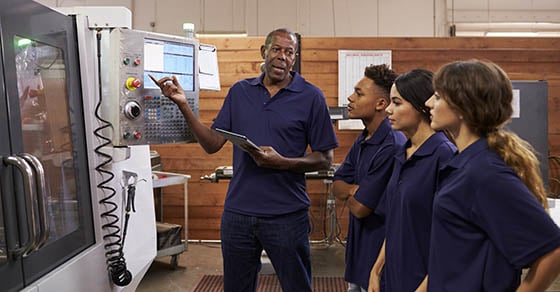Last year was another tumultuous one in the manufacturing sector. The continued impact of the COVID-19 pandemic, unprecedented disruptions to the supply chain and a competitive business environment were all contributing factors, despite a general rebound in the economy. But manufacturers are facing another major obstacle in 2022 — the ever-growing skills gap in the workforce. A possible solution to this problem is to “upskill” your workforce.
Reasons for concern
The numbers can be alarming. About one-quarter of the manufacturing industry’s workers are retiring or getting ready to retire. Plus, they’re often leaving without passing along their valuable knowledge to the younger generation of workers. At the same time, highly skilled individuals entering the workforce are being drawn to other lines of work. Why? Manufacturers are hindered by the perception that the industry is low-tech and therefore not as appealing to those starting their careers.
As the labor market continues to tighten, due in part to factors relating to the pandemic such as health concerns, the gap between the workers on board and those with the skills desperately needed continues to widen. And many manufacturers are having trouble meeting the growing demands of their customers and vendors.
Consider these statistics from Dozuki, a software producer for industrials: About 2.4 million manufacturing jobs will need to be filled by 2028, while 78% of manufacturing leaders are worried about an aging workforce. And manufacturing firms are losing 11% of their annual earnings, or $3,000 per employee, because of the talent shortage.
Taking positive steps
Nevertheless, forward-thinking manufacturers can “close the gap in skilled workers needed for operations. Here are five steps manufacturers can take to “upskill” their workforce in 2022:
1. Offer high school apprenticeships. Don’t ignore the largely untapped labor pool in high schools. Manufacturing jobs require, at a minimum, a high school degree, but few manufacturers take the time to actively recruit at high schools. Because about 30% of high school graduates don’t go to college, manufacturers are missing out on a significant pool of viable candidates. This situation can be improved through apprenticeship programs that not only provide training but also open the eyes of students toward a potentially successful career path.
2. Partner with community colleges. Community colleges can train students for the types of jobs that are opening. In particular, community colleges may be good partners because of their ready accessibility to students, close location (there are community colleges in all 50 states and the District of Columbia), flexibility in curriculum and scheduling of classes, and liberal admission policies.
3. Go mobile. Apprenticeships and partnerships with educational institutions are a good start. But manufacturers can do more by investing in upskilling through the latest technology.
In the not-so-distant past, workers frequently had to go to school at night to learn new skills. Now your company can offer virtual training opportunities with mobile applications. Workers are able to access the training on their personal devices when it best suits their schedules.
For example, a mobile solution may enable a manufacturer to create various upskilling tracks depending on its needs, combine virtual courses and reading materials for the appropriate track, and accommodate wearable technology, such as augmented reality (AR) glasses, into training sessions. This is an innovative way to facilitate training while workers are on the job.
4. Change the corporate culture. As previously mentioned, a significant contributing factor in the skills gap is the loss of knowledge and experience as senior workers retire or leave for other jobs. One practical solution is to create a shared knowledge base for employees.
Instead of fostering a “silo environment,” where information is funneled down in one direction, enable employees to communicate through a collaborative platform using direct messaging, group texts, voicemail and other communication channels. Make it easier for information to be imparted and shared. Workers can learn more from each other and know-how can be transferred to newcomers.
5. Broaden the search. All too often, workers who are good candidates for manufacturing jobs don’t pursue these positions because they’re discouraged by traditional views of shop-floor work. Reach out to potential recruits through job fairs, online services and other means to shine a positive light on the industry. When more students are apprised of the opportunities, more will likely opt for this career path. Finally, manufacturers may seek to add more women to their workforce in what has traditionally been a male-dominated industry.
Prepare for the future
While challenges abound, there’s renewed energy within the manufacturing industry. Technology is leading firm managers in directions that they couldn’t even imagine years ago.
And, with astute planning, you may qualify for top-dollar tax deductions for machinery and other qualified expenses, such as training costs. In addition, you may qualify for a Work Opportunity Tax Credit for hiring certain disadvantaged workers. These tax benefits can defray your out-of-pocket costs. Talk to your tax advisor for more information.
© 2022




